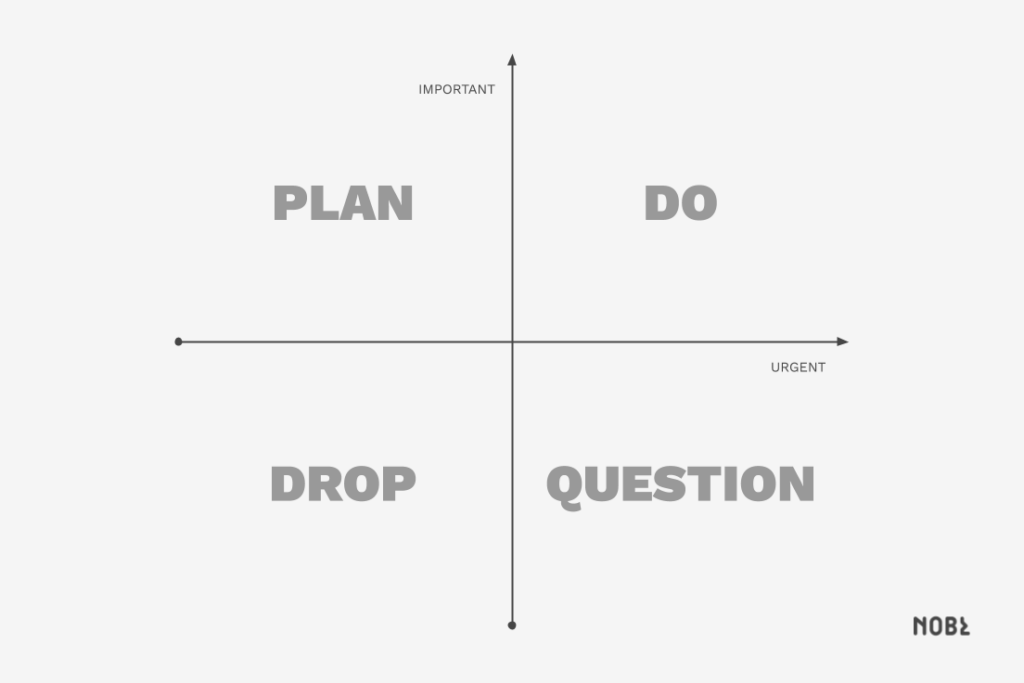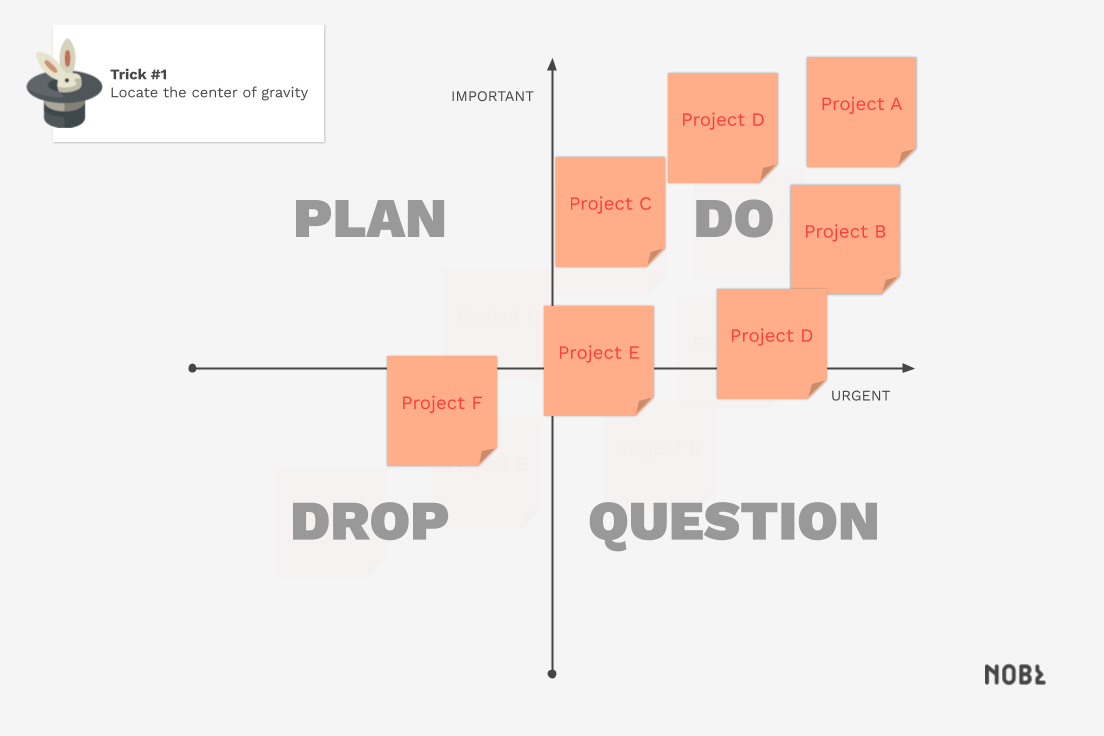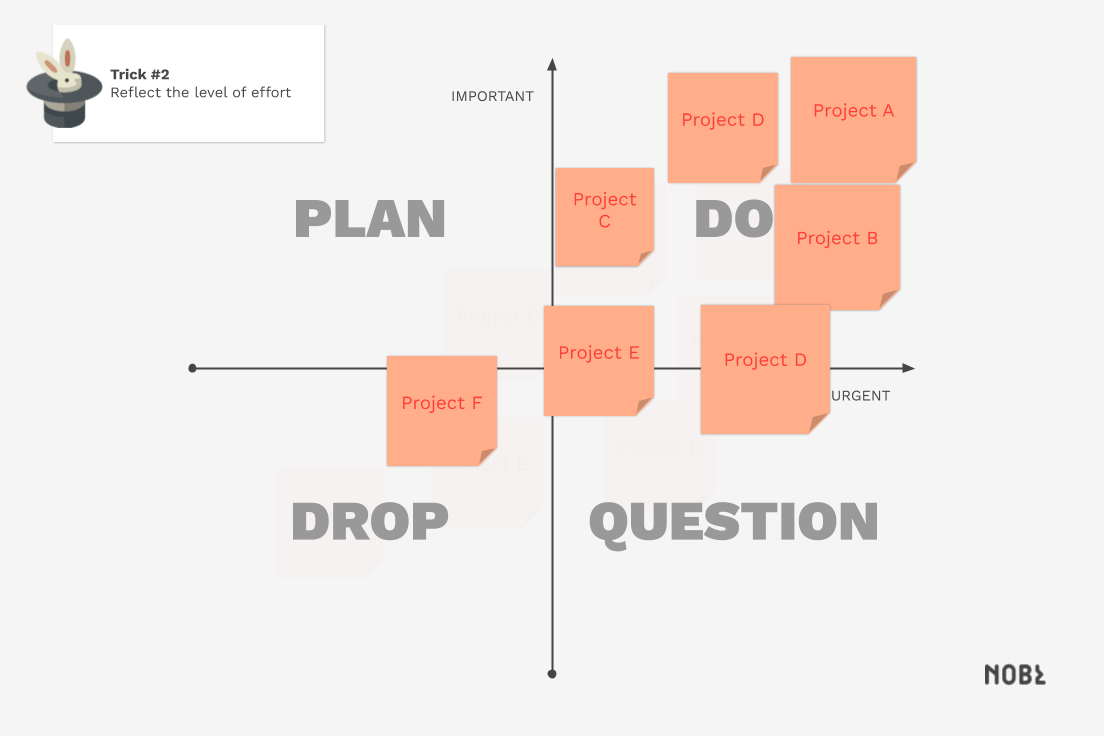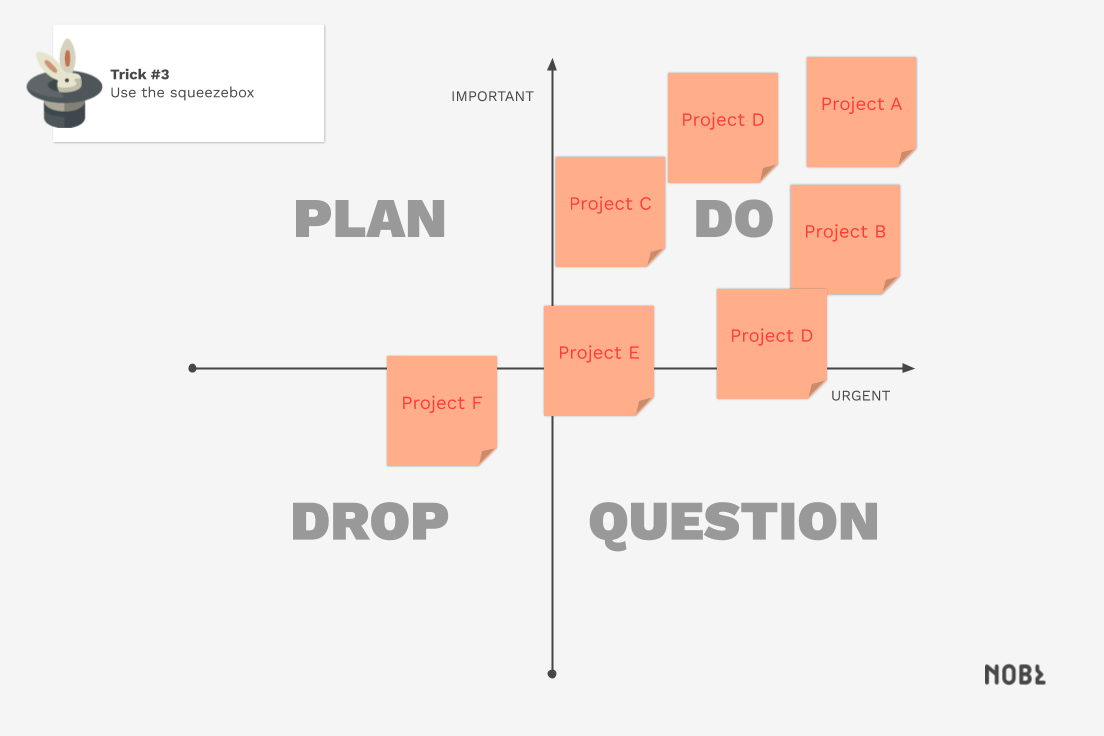If you’ve ever faced a mounting list of to-dos, chances are you’ve tried using an “Eisenhower Box”—a matrix that helps you determine what’s urgent and truly important. As the story goes, the celebrated military hero and U.S. president was so darn effective because he used this tool to ruthlessly prioritize.
Except, as far as we can find, there’s no truth to any of this.* In 1961, Eisenhower did say, “Especially whenever our affairs seem to be in crisis, we are almost compelled to give our first attention to the urgent present rather than to the important future.” But the tool as we know it first appeared as the “Time Management Matrix” in Stephen Covey’s 1989 book, “The 7 Habits of Highly Effective People,” and Eisenhower wasn’t even mentioned.

NOBL has helped executives of world-famous organizations to finally define the truly urgent and essential. Reach out to see how we might be able to help your organization.
So what if people have taken liberties with the name—it’s still a useful tool, right? Well, increasingly as we run this activity, a frustrating phenomenon occurs: everything ends up being urgent and important. Teams refuse to drop projects, claiming they’ll just do them anyway, or that they have to get done, and that’s that. Instead of helping the team prioritize, the exercise reinforces their haste, waste, and lack of focus—cementing a list of activities that are impossible to accomplish and thus ensuring the conditions for burnout and disengagement.
So, what’s to be done to prevent this inability to prioritize, or priorititis as we like to call it?
A Quick Anatomy Lesson

Before we offer three simple tricks and some words of wisdom, let’s share how we construct our Eisenhower Matrix. The classic matrix starts with a basic 2×2 grid mapping the urgency and importance of each task or project. Then come the internal labels of each quadrant, meant to serve as a guide for how to proceed with projects that fall in that area of the map. A quick google search reveals that there are an endless number of labeling variations and we encourage you to explore alternatives, yet these are ours:
- DO: For the most important and the most urgent tasks, get down to business and avoid distraction.
- PLAN: For the most important yet non-urgent tasks, begin thoughtful planning now in order to avoid late-hours or missed deadlines. Rather than the urgent present, this quadrant represents the important future—where long-term planning and deep work lies.
- QUESTION: For urgent but relatively unimportant tasks, ask the following questions: “What’s behind the urgency and is it real?” “Is this something I can automate or delegate?” “Can I accomplish the goal behind this with a lower level of effort or complication?” “What would happen if I don’t do this at all?”
- DROP: For tasks lacking in both urgency and importance, scrub them from the list entirely. This almost always triggers heartburn, so we ask teams to pre-mortem what might happen if they were erased and if those consequences are worth the effort and certain distraction. When teams still push back, we ask them to try ignoring the task for thirty-days and report back.
Even with this guidance, leaders and teams again and again default to cramming their entire project list in the “DO” area of the map, effectively rendering the exercise moot. When this happens, we try the following tricks and then ask the team or individual to react.
Trick #1: Locate the Center of Gravity

After the individual or team has placed all of their tasks and projects onto the map, we simply shift either the axes or projects themselves until everything is centered. This effectively rebalances the frames of reference, or centers of gravity, for how importance and urgency are defined. This trick forces the individual or team to respect the spirit of the tool and compare tasks/projects against one another versus an internalized desire to do everything.
Trick #2: Reflect the Level of Effort

Another way to avoid an over-bloated “DO” quadrant is to force the individual or team to first size the tasks/projects (try the agile estimation technique of starting with relative t-shirt sizes, e.g. small, medium, large, x-large) and don’t allow any overlapping post-its or icons. This trick forces the individual or team to respect their own scarcity of time and resources.
Trick #3: Use the Squeezebox

There’s no law saying that a 2×2 must have 90-degree angles. In fact, you can better reflect the inherent scarcity of time, attention, and resources by skewing the Eisenhower Matrix and reducing the overall area of the “DO” quadrant. This trick forces the individual and team to be honest about their ability to focus.
Hacking at the Roots of Priorititis
While the above tricks are useful in the moment of prioritization, the causes of a crammed “DO” quadrant are systemic and strategic.
If you find yourself or your team struggling to prioritize, investigate if any of these frequently-cited conditions or causes are at play:
- Do you really know who you are serving? If you’re organizing your own personal to-do list, have you stepped back to ask yourself what really matters to you? What do your core beliefs and values compel you to prioritize? If you’re organizing your work list, or your team’s, do you know who that work is serving and what those constituents value most? Or are you simply guessing by throwing spaghetti at the wall and seeing what sticks?
- Is your strategy lacking any clear articulation of tradeoffs? Strategy, after all, is about making choices. After you get clear on who you are serving, try framing your strategy (or even your personal values) in terms of “even over” statements to help you force the necessary choices that will make prioritization less confusing.
- Is there someone above you or your team that is driving an unrealistic sense of urgency? First, be sure they themselves have defined their strategies in terms of tradeoffs (based on an understanding of your customers) and then work to make the cost and consequences of those unrealistic expectations transparent. Start with good faith and over-communicate your or your team’s timelines and available bandwidth and keep them regularly updated on progress and momentum. If that information falls on deaf ears, don’t take it personally (this is the work of managing-up). You could try investigating where their sense of urgency is coming from in (e.g. someone even above them driving urgency) in order to find solutions and/or you could look for opportunities to positively reinforce behavior when they do acknowledge your abilities and availabilities.
- Have you fallen into a pattern of fire-fighting? The act of fighting workplace fires, i.e. rallying to answer an urgent need, can be addicting. You and/or your team are recognized as heroes, especially in the eyes of organizations with short-term myopia, and you can become dependent on seeking that recognition. Ultimately, though, you starve your resources and ability to plan for the long-term and accomplish bigger, more impactful initiatives.
*If you’ve got proof otherwise, send it to us!













